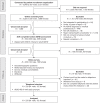Health-Related Quality of Life and Work Productivity of Adults With ADHD: A U.K. Web-Based Cross-Sectional Survey
- PMID: 30215265
- PMCID: PMC6732822
- DOI: 10.1177/1087054718799367
Health-Related Quality of Life and Work Productivity of Adults With ADHD: A U.K. Web-Based Cross-Sectional Survey
Abstract
Objective: The objective of this study was to assess health-related quality of life (HRQoL) in adult ADHD.
Method: U.K. residents aged 18 to 55 years with ADHD and no major mental health comorbidities completed an online survey of disorder history, the EuroQoL 5-Dimensions 5-Level (EQ-5D-5L), and the Work Productivity and Activity Impairment Questionnaire: General Health (WPAI:GH). ADHD Rating Scale-IV (ADHD-RS-IV) score was assessed by telephone.
Results: In total, 233 participants completed the study (mean age 32.6 years; 65.2% women). Mean ( SD) ADHD-RS-IV total score, EQ-5D utility, and visual analog scale (VAS) scores were 43.5 (7.88), 0.74 (.21), and 69.8 (17.76), respectively. Mean ( SD) WPAI:GH scores indicated that health problems caused 45.7% (29.9) overall work impairment and 45.8% (28.9) impairment in regular daily activities. Greater work and activity impairment were both significantly independently associated with lower utility after adjusting for age, gender, and somatic comorbidities.
Conclusion: Adult ADHD impairs HRQoL, work productivity, and regular daily activities.
Keywords: ADHD; EQ-5D; WPAI:GH; adult; health-related quality of life.
Conflict of interest statement
Figures

References
-
- Adler L. A., Dirks B., Deas P., Raychaudhuri A., Dauphin M., Saylor K., Weisler R. (2013). Self-reported quality of life in adults with attention-deficit/hyperactivity disorder and executive function impairment treated with lisdexamfetamine dimesylate: A randomized, double-blind, multicenter, placebo-controlled, parallel-group study. BMC Psychiatry, 13, Article 253. doi:10.1186/1471-244X-13-253 - DOI - PMC - PubMed
-
- American Psychiatric Association. (1994). Diagnostic and statistical manual of mental disorders (4th ed.). Washington, DC: Author.
-
- American Psychiatric Association. (2013). Diagnostic and statistical manual of mental disorders (5th ed.). Arlington, VA: American Psychiatric Publishing.
-
- Asherson P., Manor I., Huss M. (2014). Attention-deficit/hyperactivity disorder in adults: Update on clinical presentation and care. Neuropsychiatry, 4, 109-128. doi:10.2217/npy.14.16 - DOI
LinkOut - more resources
Full Text Sources
Other Literature Sources

